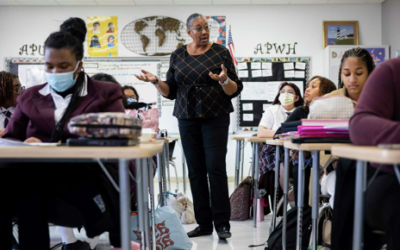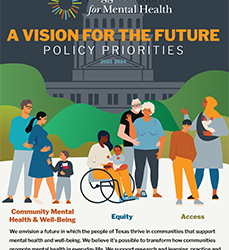Safe and Supportive Schools in Texas
Learning is fostered in environments where students feel safe, engaged, connected and supported.Let’s Create Safe and Supportive Schools for Every Texas Student
As we all look at COVID-19’s effects, the mental health and emotional impact on our kids is evident: trauma, depression, substance use, and suicidal thoughts have all risen the last two years. While the pandemic undoubtedly exacerbated our youth’s struggles, their need for mental health supports is not new. Students have witnessed mass shootings targeting schools and specific populations, national conversations on race, and extreme weather events. These experiences have profound impacts on children’s mental health.
Recommendations
It is imperative that Texas promote and financially invest in these strategies. According to The Collaborative Task Force on Public School Mental Health Services created in response to the Santa Fe High School shooting, one key finding was “there is no dedicated state funding allocated to school districts specifically for the provision of school-based mental health services.” Texas can support its schools by:
Directing funding to school for school-based mental health services and school climate strategies by creating a school mental health allotment; require TEA to collect data on how those funds are spent annually.
Allowing schools to enroll as a Medicaid provider through the existing SHARS program for the specific purpose of providing behavioral health services to any student eligible for Medicaid.
Addressing schools’ code of conduct to better support school mental health, including data collection to increase transparency of student removals.
Supporting School-wide Mental Health to Create Safer Schools
 Mental illness itself does not predict dangerousness. After a school shooting, discussions can quickly focus on the need for increased mental health services. However, there is often misinformation that attempts to connect mental health services with safety, incorrectly inferring a link between mental illness and violence. Research shows us that loneliness, isolation, anger, and despair are more accurate predictors of violence than a mental health diagnosis. These are not diagnosable mental illnesses, but conditions brought on by societal drivers that create unhealthy communities and therefore unhealthy individuals. Psychotropic medications and psychiatric care are not going to cure this. A focus on mental health will not identify the “next school shooter,” but a focus on creating safe and supportive schools for every student can make a positive movement toward the well-being of students. Providing accessible mental health services is imperative for the response to community trauma and combating the wide array of difficulties our kids face today.
Mental illness itself does not predict dangerousness. After a school shooting, discussions can quickly focus on the need for increased mental health services. However, there is often misinformation that attempts to connect mental health services with safety, incorrectly inferring a link between mental illness and violence. Research shows us that loneliness, isolation, anger, and despair are more accurate predictors of violence than a mental health diagnosis. These are not diagnosable mental illnesses, but conditions brought on by societal drivers that create unhealthy communities and therefore unhealthy individuals. Psychotropic medications and psychiatric care are not going to cure this. A focus on mental health will not identify the “next school shooter,” but a focus on creating safe and supportive schools for every student can make a positive movement toward the well-being of students. Providing accessible mental health services is imperative for the response to community trauma and combating the wide array of difficulties our kids face today.
Autism and Mental Health
For Autism Awareness Month, a collaboration from a mother and son, about his lived experience with autism and mental health.
Teaching in a Time of Division
In episode 144, we speak with two public school teachers about their experiences teaching in a time of cultural and political division
A Vision for the Future: Policy Priorities, 2023-2024
We support research and learning, practice and implementation, and policy initiatives to achieve this vision.
Creating Positive School Climates
 While crisis services are an important component in a full continuum of care, the goal should be an upstream and preventative approach– we should focus on creating positive school climates, and building relationships between students, staff, and the community before a crisis occurs. For many kids, school is often the first intervention when services or supports are needed. Support can be as simple as a safe adult to talk to. Not every kid will need clinical or crisis services. Cultivating well-being at schools includes a wide array of school-wide practices that improve the school climate, including the availability of comprehensive school-based mental health services. A comprehensive approach to school-based mental health focuses just as much on mental health promotion and prevention as it does on intervention and treatment. These strategies not only provide support to kids with a diagnosed mental health condition but benefit all students. Strategies can include implementing Positive Behavior Interventions and Supports (PBIS), trauma-Informed practices, or restorative discipline. These strategies not only impact the mental health and well-being within schools, but also improve academic achievement—increasing test scores, attendance, grades, and graduation rates, while decreasing truancy and disciplinary rates.
While crisis services are an important component in a full continuum of care, the goal should be an upstream and preventative approach– we should focus on creating positive school climates, and building relationships between students, staff, and the community before a crisis occurs. For many kids, school is often the first intervention when services or supports are needed. Support can be as simple as a safe adult to talk to. Not every kid will need clinical or crisis services. Cultivating well-being at schools includes a wide array of school-wide practices that improve the school climate, including the availability of comprehensive school-based mental health services. A comprehensive approach to school-based mental health focuses just as much on mental health promotion and prevention as it does on intervention and treatment. These strategies not only provide support to kids with a diagnosed mental health condition but benefit all students. Strategies can include implementing Positive Behavior Interventions and Supports (PBIS), trauma-Informed practices, or restorative discipline. These strategies not only impact the mental health and well-being within schools, but also improve academic achievement—increasing test scores, attendance, grades, and graduation rates, while decreasing truancy and disciplinary rates.
Connection versus Punitive Responses
Unfortunately, mental health conditions, substance use, or trauma can be misidentified as “bad” behavior. Without other resources, classroom removals are often implemented. Despite the lack of evidence that exclusionary discipline is an effective method of changing student behavior, it is often used. A majority of removals in Texas are due to a code of conduct violation, so we do not know why many students are disciplined or what is needed to support teachers in the classroom. What we do know is punitive discipline negatively affects students’ sense of safety, well-being, and ability to learn, while increasing the likelihood of lowered academic performance, dropping out, antisocial behavior, and future contact with the justice system. Teachers and schools need the proper resources to ensure classrooms are adequately managed, everyone feels safe, and teachers can focus on teaching.
Improved School Climate Supports Teachers
Stress and trauma can affect various aspects of a student’s school experience: behavior in class, interpersonal relationships, and mental health, which all can impact their interactions with a teacher.
Ultimately, this may interfere with the classroom environment and a teacher’s ability to teach. Legislators repeatedly hear that “teachers just want to teach,” so we must support them to do their jobs. When students’ mental wellness is addressed, the school climate is improved for all, including teachers and staff. Supporting mental health in schools and improving the school’s climate leads to teachers feeling better supported, higher rates of job satisfaction and teaching efficacy, healthier classroom environments and student-teacher relationships, and lower levels of stress.
Students who are emotionally and mentally well engage better in learning.
Already overburdened teachers can experience burnout from lack of resources or support while attempting to manage diverse issues in the classroom, including unaddressed mental health concerns. Championing school-wide practices that support mental health and well-being throughout the school is vital during a time of dire teacher workforce challenges.
Download Our One-Pager
The task ahead for Texas is considerable. The Hogg Foundation and other mental health stakeholders are aware of strategies that can help create safe and supportive learning environments for every student. Our one pager presents the same information you’ve read here, cites our sources, and provides recommendations to creating a safer and more supportive school environment for all of our children and teens.



